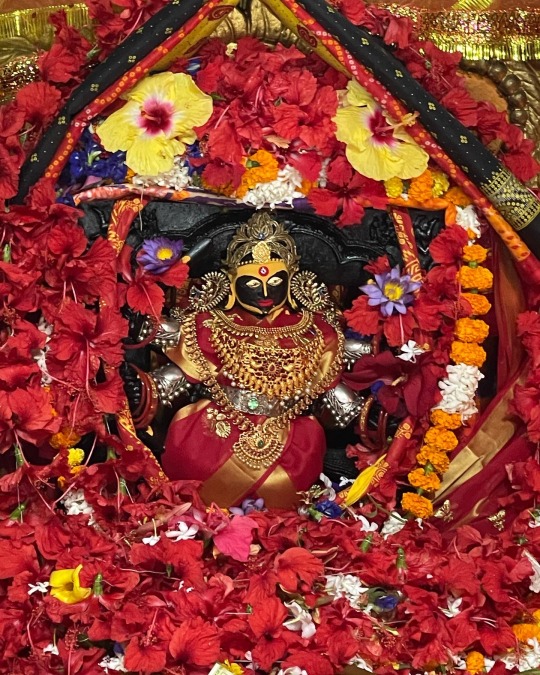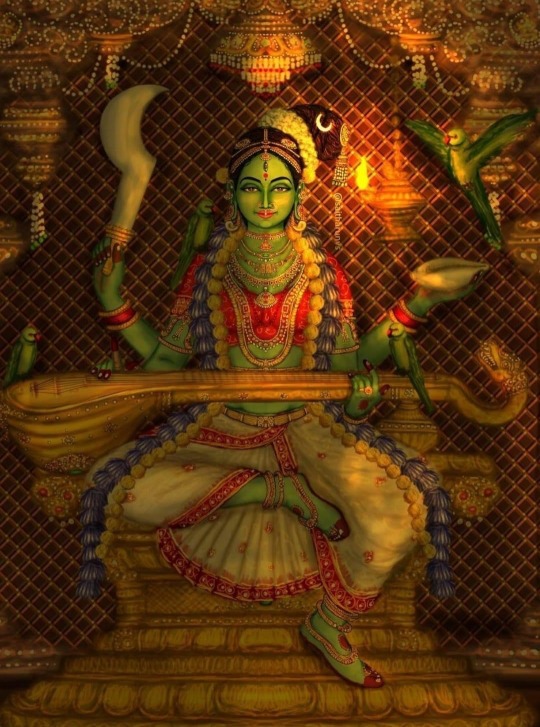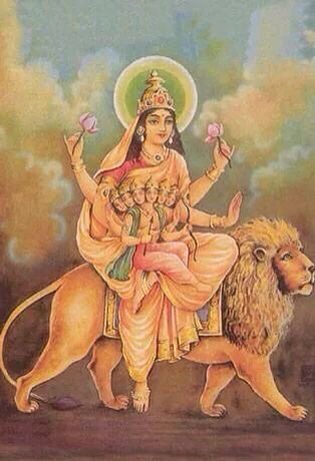Text
Goddess Chinnamasta - “She Whose Head is Cut Off”

Chinnamasta, a Hindu Goddess and the sixth cosmic wisdom in Dus Mahavidya, is visually fierce but spiritually evolved, tender and compassionate sixteen year old who cuts her own head to feed the ones who come to her by granting them protection and fulfilment.
Spiritually, “She whose head is cut off” represents the unlimited capacity of transcending the mind and be absorbed in the Supreme Void of the Absolute Divine Consciousness. Further, it also implies transcending the mind by separating from identity or ego.
Though visually ferocious, like Kali, her divine and electrifying personality reveals the uniqueness of the infinite divine consciousness, that is nameless, formless and limitless, holding a pure vision that goes beyond any veil of ignorance resulting in thundering spiritual transformation. Hence, Chinnamasta is called Prachanda Chandika, identifying herself with the most terrible form of Kali, which is Chandi.
Due to her association with the ascending energy through Sushumna Nadi, Chinnamasta is also correlated with the subtle energy causing the ascension of Kundalini Shakti and the deep transformation of the human being. There are in fact three streams of blood coming out from Chinnamasta’s throat: a central stream that she herself drinks, and two other placed on the left and on the right sides of this central stream, signifying the energies from ida nadi and pingala nadi, drunk by the two yoginis Dakini and Varini.
In the Pranamayakosha or the energy body, there are 72,000 nadis, pathways
Of energy or prana in the system. The 72,000 nadis spring from three basic nadis – the left, the right and the central – the Ida, Pingala, and Sushumna.
Ida, the feminine representing the moon, is the left channel. It originates in Muladhara, Ida ends up in the left nostril.
Pingala, the masculine representing the sun, is the right channel. It originates in Muladhara, Pingala ends up in the right nostril.
Sushumna is the central channel through which Kundalini moves upwards running up the body from just below Muladhara chakra to Sahasrara chakra at the crown of the head, thus energising the seven chakras.
The ability to balance Ida and Pingala, and cause Prana to flow in Sushumna results in an inner balance where whatever happens outside, there is a certain space within you which never gets disturbed and scale up the peaks of consciousness.
134 notes
·
View notes
Text

#ugratara #temple #odisha
Tara comes from SITA RAM it has TA of Sita and RA of RAM.
According to #Yogini #Tantra, #Tara is the same as #Kali , the embodiment of supreme #love. She is also #Kamakhya. In Tantric literatures three manifestations of Tara are mentioned: Eka Jata, providing Kaivalya or unity with the Absolute; Ugra Tara, one who provides relief from unforeseen severe meseries and Nila Saraswati, imparting Jnana or knowledge.
She stands in the Pratyalidha pose. She is short stature with a protruded belly and Her complexion is dark blue. She has a terrible appearance away from her mild and pretty Sarasawati appearances. She wears tiger skin at Her waist and garland of human-heads at Her neck.
She is of prime youth and adorned with Pancha Mudras. In Her four hands She holds Khadga-sword, Indivara-lotus, Kartika-shear and Kapala-human skull. Her tongue is held out as Kali’s lolling tinge. She wears single braid of matted hair on her head. Tara is three-eyed as she stands on the corpse lying on the burning funeral pyre and ranges her feet, which appears terrible. These are symbolic of Mother Kali, ever ready to remove the darkness of ignorance and passiveness of Her devotees. Ma Tara is synonymous with Omkar, the five
components of Omkar are – A, U, M, Nada and Bindoo
What I love the most of compassionate is her mother love for #shiva
The legend begins with the churning of the ocean between the Devas and Asuras. Lord Shiva drank the poison that was created from the churning of the ocean (in the process turning his throat blue and earning him the epithet Nilakantha), thus saving the world from destruction, but fell unconscious under its powerful effect. Tara Ma appeared and took Shiva on her lap. She suckled him, the milk from her breasts counteracting the poison, and he recovered. It is reminiscent to Kali's maternal instinct when Shiva stops the rampaging Kali by becoming an infant and Kali becomes quiet and nurses the infant Shiva. In both cases, Shiva assumes the position of an infant vis-à-vis the Goddess.
May the compassionate Ma Ugratara shows us the way from #darkenesstolight
ॐ त्रीं ह्रीं, ह्रूं, ह्रीं, हुं फट्॥
Om Treem Hreem, Hrum, Hreem, Hum Phat॥
3 notes
·
View notes
Text
Greetings on these auspicious Magha Navaratri.
Magha Navaratri is celebrated in the lunar month of Magha in hinduism. It is also known as Gupt Navaratri, because personalized sadhnas are majorly performed these days to please certain manifestations of Devi, in whose worship secrecy is maintained. Secrecy means, more involvement with the divine, to fathom our true nature which unfolds with her grace. This True Nature is fundamentally discussed in shastras as the Aananda Svarupa or form of divine bliss. This bliss is recognised during Navaratris with the worship of Shakti, whose spandan/movement gave birth to universe and created eroticism and bliss in existence. As the root life force of cosmos, the blissful and erotic, life-giving energy which is Devi lives in all life forms.
Matangi and her different forms are worshipped during these Navaratris in Shakta traditions of Shyamala, Sri Vidya and others. Matangi is one of the Dasha Mahavidyas, who grants spiritual and materialistic wisdom, proficiency in arts and music and attraction/vasikarana. Attraction or Vasikarana is an important quality of Devi, as she attracts all devotees and seekers towards spirituality. Matangi is worshipped as Saraswati in the Vedas, and as Ucchishta Chandalini in the tantras. Devi is ferocious, but grants auspicious boons to her bhaktas. Authentic worship of Matangi must be performed only by receiving initiation in her mantra and worship from a genuine Guru/Master.
In absence of initiation, Goddess can be worshipped as Saraswati by devotees. Recitation of Saraswati Sahesranamam, Saraswati Ashtottram and Medha Suktam is beneficial in receiving the abundant grace of Matangi/Saraswati. If recitation is difficult, listen to these stotras and suktas.
May these auspicious days of Magha Navaratri bring grace and wellbeing to your lives. May Devi's blessings be upon you.
Magha Navaratri dates: 2nd February - 11th February, 2022.
Picture artist: Sai Tharun Vs.
#navaratri #maghamasam #magha #matangi #mahavidya #shakti #puja

4 notes
·
View notes
Text

भक्ति में ही शक्ति है।
May the Ten Goddesses of deeper wisdom grant us fearless warrior spirit, infinite energy and help us drop the egoic intellect creating a space within for inner wisdom to grow and steer our lives in the direction of peace, love and happiness.
Shubha Navratri! 🌺
#dusmahavidya #navratri
7 notes
·
View notes
Text

The 4 days Raja festival, which started as a tribal practice, has now spread to all parts of Odisha respecting and celebrating menstruation and womanhood.
As per the mythology, It is believed that the mother Goddess Earth or the divine wife of Lord Vishnu undergoes menstruation during the first three days. The fourth day is called Vasumati Snana, or ceremonial bath of Bhudevi. The term Rajo came from Rajaswala (meaning a menstruating woman), and in medieval times the festival became more popular as an agricultural holiday marking the worship of Bhudevi, who is the wife of lord Jagannath. A silver idol of Bhudevi is still to be found in the Puri Temple beside Lord Jagannath @wikipedia
Read more https://en.m.wikipedia.org/wiki/Raja_(festival)
#celebratingwomanhood #womenempowerment #girlpower #equalitymatters #festivalsofodisha
#festivalsofindia
3 notes
·
View notes
Text

UNITY
We live in everyone. I live in you. You live in me. There is no gap, there is no distance.
#amitray
#shiva and #shakti
2 notes
·
View notes
Text
Greetings for Maha Shivratri 🙏

When you take a chance and do the things you love your soul sparkles with cosmic trust.
@tarinithegoddess
16 notes
·
View notes
Text
Naudurga: Siddhidatri

The ninth incarnation of Goddess Durga is Siddhidatri. She appeared from the left half of Lord Shiva. She is the Goddess who possesses and bestows all type of Siddhis to her devotees. Even Lord Shiva got all Siddhis by grace of Goddess Siddhidatri. Lord Shiva also got to be known as Ardha- Narishwar when Goddess Siddhidatri appeared from his left half.
On the ninth and the last day of Navratri, October 7th, we invoke her wearing the vibrant peacock blue to bless us with constructive and generative powers to live a life of unity and harmony.
25 notes
·
View notes
Text
Naudurga: Mahagauri

The eight incarnation of Maa Durga is Mahagauri, meaning extremely fair in complexion and beautiful because of which she is compared with the conch, the moon and the white flower of Kunda As she adorns white clothes she is also called Shwetambardhara.
As per Hindu philosophy, the girls are considered as the manifestation of the natural force of creation. On the eight or the ninth day Kanya puja is done. This ceremony primarily involves the worship of nine young girls and a young boy, representing the nine forms of Goddess Durga and the boy representing Bhairav.
On the eight day of Navratri, October 6th, we invoke Goddess Mahagauri wearing the royal purple to grant us with wealth and wisdom and to get rid of all negativity from our lives.
25 notes
·
View notes
Text
Naudurga: Kalaratri

The seventh incarnation of Maa Durga is Kalaratri. She is the fiercest and the most ferocious form of Goddess Parvati and has dark black complexion as she removed her golden skin to kill demons named Shumbha and Nishumbha. Kalaratri is widely regarded as one of the many destructive forms of the Mother Goddess, which include Kali, Mahakali, Bhadrakali, Mrityunjay, Rudrani, Chamunda, Chandi and Durga. Because she makes her devotees fearless granting auspicious results she is also known as Goddess Shubhankari.
On the seventh day of Navratri, October 5th, we invoke Goddess Kalaratri wearing the timeless grey colour to grant us with a warrior spirit- that will make us fearless in looking inward and going beneath to trace the truth, as well as help to release all that no longer serves us.
102 notes
·
View notes
Text
Naudurga: Katyayani

The sixth incarnation of Maa Durga is Katyayani, the warrior Goddess. To destroy demon Mahishasura, Goddess Parvati took this most violent form. As she was born at the home of sage Katya and due to which this form of Goddess Parvati is known as Katyayani. She is also known to be the sister of Lord Krishna.
On the sixth day of Navratri, October 4th, we invoke Goddess Katyayani wearing the refreshing and natural green to renew ourselves to be a voice and not an echo.
33 notes
·
View notes
Text
Naudurga: Skandamātā

The fifth incarnation of Maa Durga is Skandamātā where the Goddess Parvati becomes a mother of Skanda, which is another name for her son Kartikeya and Mata is the term for mother. Ma Skandamata is worshipped as the mother of a supremely gifted six faced child. When a devotee worships Skandamata, Lord Kartikeya is also worshipped as he is sitting in her mother’s lap.
On the he fifth day of Navratri, October 3rd, we invoke her wearing the optimistic and warm yellow to bless us with peace, prosperity and mother’s love.
27 notes
·
View notes
Text

Naudurga: Kushmanda
The fourth incarnation of Maa Durga is Kushmanda. Ku means "a little", Ushma means "warmth" or "energy" and Anda means "cosmic egg". With the power and capability to live inside the Sun she is the creator of the Universe spreading her light across like the rays of the sun. The glow and radiance of her body is as luminous as that of the Sun. There is a 1000 years old mysterious temple in Kanpur of Goddess Kushmanda where her idol is found in a lying posture in a small pool of water that never dries up and its source is unknown.
On the fourth day of Navratri, October 2nd, we invoke her wearing the radiant royal blue.
In blue you are truer than true. There is no one alive who is youer than you.
21 notes
·
View notes
Text
Naudurga: Chandraghanta

The third incarnation of Maa Durga is Chandraghanta. She is the married form of Parvati. Her name Chandra-Ghanta means "one who has a half-moon shaped like a bell. Her third eye is always opened and she always ready for war against evil. She is also known as Chandrakhanda, Chandika or Rannchandi.
On the third day of Navratri, October 1st, we invoke her wearing passionate and powerful red to reward us with her grace, bravery and courage. By her grace all the sins, distresses, physical sufferings and mental tribulations are eradicated.
16 notes
·
View notes


